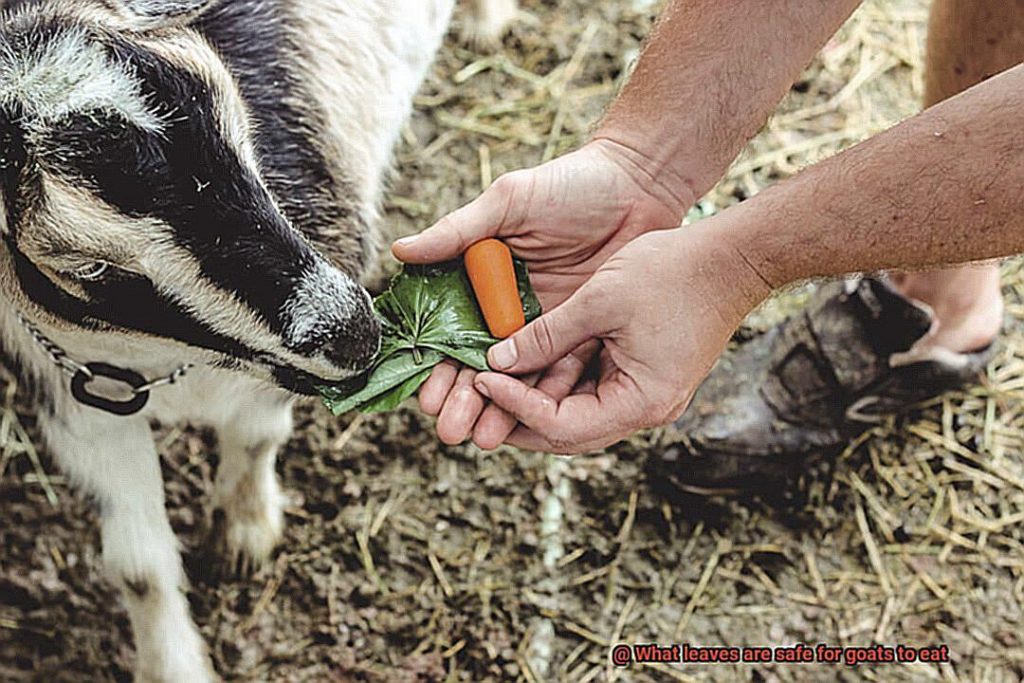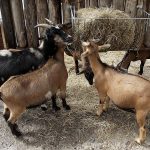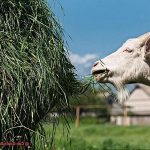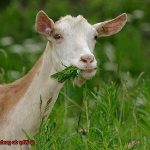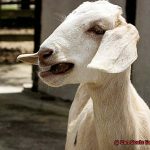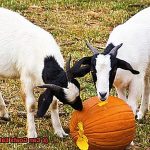Are you thinking about adding goats to your farm or keeping them as pets? If so, it’s crucial to know what kind of food will keep your new livestock healthy and content. While goats are known for their insatiable appetite, not all leaves are safe for them to eat. That’s where we come in.
In this blog post, we’ll cover everything you need to know about which leaves are safe for goats to munch on. From a comprehensive list of nutritious options to common toxins and dangers, we’ve got you covered.
But our discussion doesn’t stop there. We’ll also delve into the importance of a balanced diet for your goats and how incorporating certain leaves can enhance their environment while keeping them healthy. Whether you’re raising goats for meat, milk, or ornamental purposes, this post will provide you with valuable insights into ensuring your goats eat well and live happily. So grab a pen and get ready to take some notes as we explore the world of goat diets together.
What are Goats?
Contents
Goats are fascinating domesticated mammals that have been a crucial part of human civilization for thousands of years. They belong to the Bovidae family, which includes sheep and cattle, and come in various breeds. Generally, they have a compact body covered in short fur or hair that comes in different colors such as white, black, brown, and gray. Additionally, they have two curved horns on their head and a long beard, making them quite an impressive sight.
Goats are social animals that prefer to be in herds. They are known for their agility and climbing ability due to their inner ear balance and special hooves that help them grip onto surfaces. In terms of diet, goats are browsers, which means they prefer to eat leaves, twigs, and shrubs rather than grazing on grass like cows or sheep. Their digestive system can quickly handle a variety of plant material, including leaves from trees and shrubs.
Now that we understand what goats are let’s dive into what leaves are safe for them to eat. One of the safest leaves for goats is alfalfa. Alfalfa is highly nutritious and contains essential vitamins and minerals that goats need. It is also high in protein, making it an excellent choice for pregnant or lactating goats.
Another safe leaf for goats is clover. Clover is a good source of protein and energy for goats; however, it should be fed in moderation as it can cause bloating in some goats.
Fruit tree leaves such as apple, pear, and peach trees are also safe for goats to consume. These leaves provide fiber and nutrients but should not be the primary source of food as they can be high in sugar.
Furthermore, raspberry leaves, blackberry leaves, and mulberry leaves are all safe choices for goats. Raspberry and blackberry leaves are known to help with diarrhea and respiratory issues in goats, while mulberry leaves contain antioxidants that boost the immune system.
It’s important to note that not all leaves are safe for goats to eat. Some plants, such as rhododendrons, can be toxic and harmful to their health. So, ensure that you research before giving any new leaves to your goats.
What Leaves are Safe for Goats to Eat?
However, not all leaves are created equal, and it’s essential to know which ones are safe for your goats to eat. After all, their health and well-being depend on it.
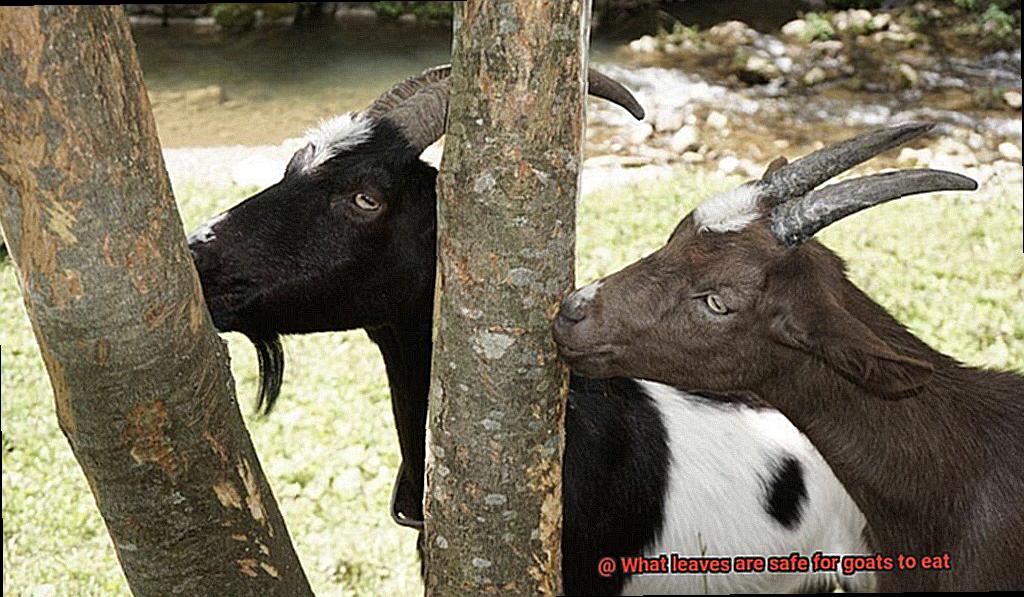
Luckily, there are plenty of safe leaf options for goats. Alfalfa, clover, timothy hay, and Bermuda grass are all excellent choices. These leaves are high in nutrients and fiber, providing your goats with a well-rounded diet. Plus, they’re easy to find at your local feed store.
But the fun doesn’t stop there. Goats also enjoy snacking on blackberry, raspberry, and strawberry leaves. Not only do these leaves provide additional nutrients, but they’re also a delicious treat for your furry friends. Just make sure to double-check that the leaves are free of pesticides and harmful chemicals before feeding them to your goats.
Of course, not all leaves are safe for goats to eat. Steer clear of cherry trees, rhododendrons, azaleas, and yew plants as their leaves can be toxic and harmful to your goats’ health. Additionally, oak leaves contain tannins that can cause kidney damage if consumed in large quantities.
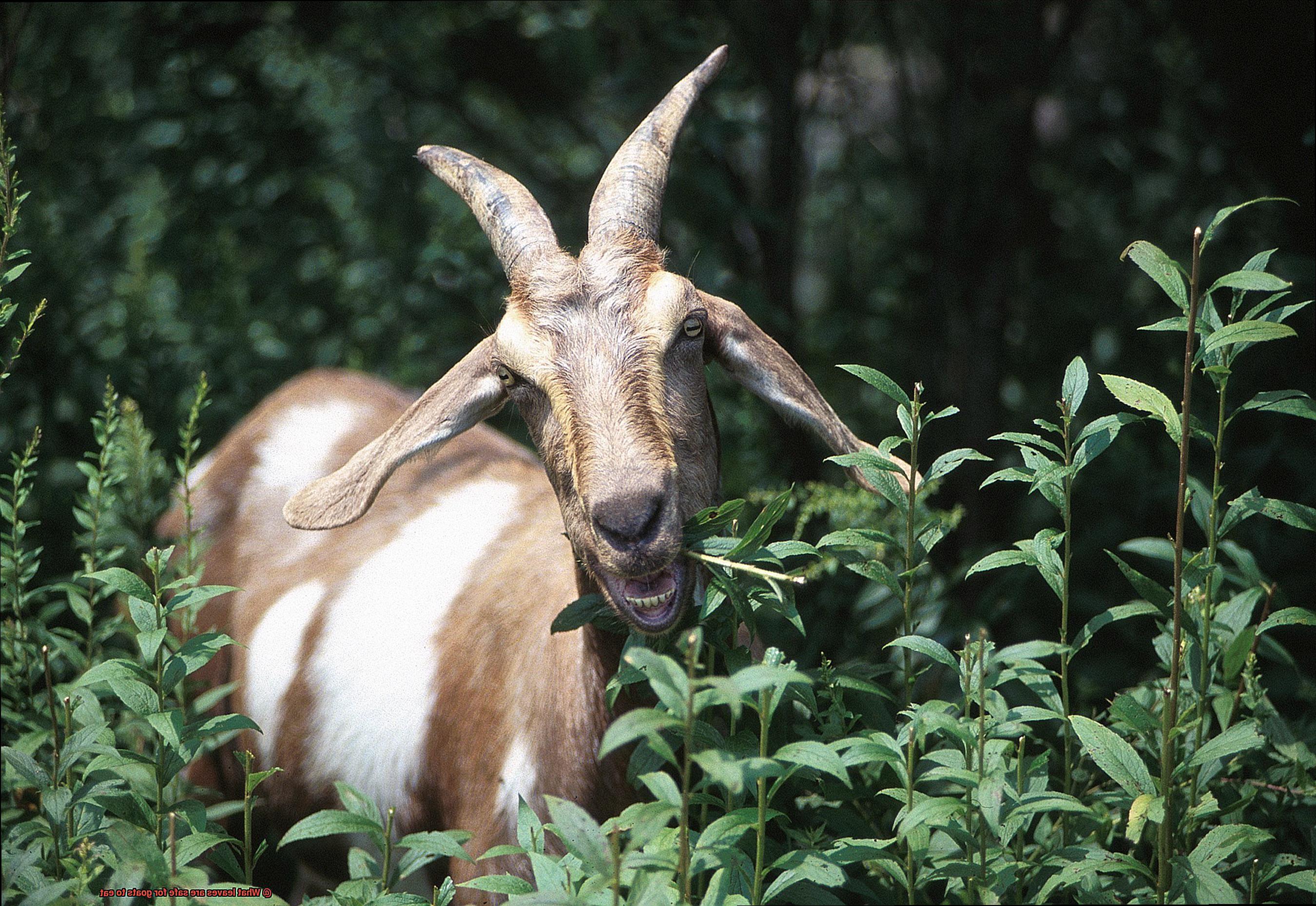
Alfalfa
One of the most popular questions is whether it is safe to incorporate alfalfa into a goat’s diet.
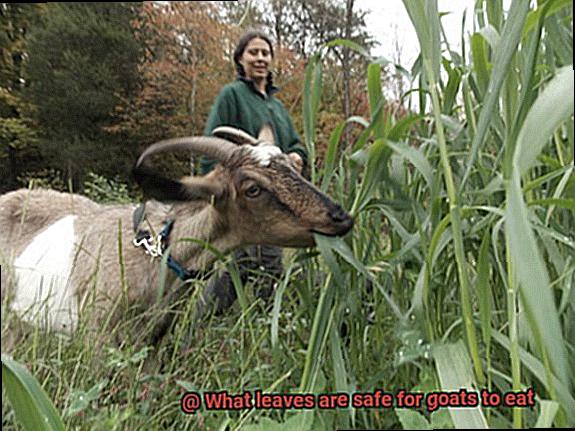
Alfalfa is a highly nutritious forage crop that is packed with protein, fiber, and essential vitamins and minerals. However, it’s critical to note that alfalfa should be administered in moderation since overfeeding can lead to urinary calculi or kidney stones, particularly in male goats.
To ensure a well-balanced diet for your goats, it is best to feed them a combination of alfalfa hay and grass hay. When feeding your goats alfalfa, it’s crucial to choose high-quality hay that is free of mold and dust. Goats are selective eaters and may avoid hay that is not fresh or has an unpleasant smell.
In addition, it’s vital to introduce alfalfa gradually into a goat’s diet to avoid digestive problems. While alfalfa leaves are generally safe for goats to consume, it’s essential to monitor their intake. Goats that overindulge in alfalfa leaves may experience bloating or diarrhea.
Clover
It is a common plant found in pastures and can be an excellent source of nutrition for your beloved goats. However, not all types of clover are safe for goats to eat, so it’s crucial to understand the benefits and risks before making any dietary changes.
Red and white clover are both safe options that offer numerous nutritional benefits to your goats. They contain plenty of protein and minerals that can supplement a balanced diet for your goats. Additionally, these types of clover naturally contain phytoestrogens, which can help regulate the reproductive system in female goats.
However, it’s important to avoid alsike clover as it contains a toxin called slaframine. This toxin can cause excessive salivation and diarrhea in goats. Although small amounts of alsike clover may not cause harm, it’s still best to steer clear of it altogether.
One potential risk associated with feeding clover to goats is bloat. Bloat is a serious condition where the stomach fills with gas, causing pressure on the diaphragm and making it difficult for the goat to breathe. To prevent bloat, it’s essential to introduce clover gradually into your goat’s diet and monitor their intake closely.
Fruit Tree Leaves
While these leaves can offer a fantastic source of nutrition, it’s crucial to know which ones are safe for your goats to eat.
First off, the good news: apple and pear tree leaves are not only safe but also nutritious. These leaves are packed with vitamins A, B, and C, as well as calcium and phosphorus. For goats who struggle with digestion, pear tree leaves are an especially great option as they’re high in fiber.
But not all fruit tree leaves are created equal. Cherry tree leaves contain cyanide, which can cause respiratory distress, convulsions, and even death in goats. Similarly, peach tree leaves also contain cyanide and should be avoided. And while some fruit tree leaves may be safe for goats to eat, the fruit itself may not be. For example, avocado fruit is toxic to goats and can cause heart failure if ingested in large amounts.
To ensure your goat’s safety, always research before offering them any kind of fruit tree leaf as a snack. It’s better to be safe than sorry. Check if the leaf is safe for consumption before feeding it to your goats.
Other Safe Leaves for Goats
While hay and grains are the most common types of feed for goats, there are other leaves that you can include in their diet. These safe leaves not only provide essential nutrients but also have medicinal properties that can help prevent diseases.
Mulberry leaves are a great option for goats as they are rich in vitamins A and C, iron, and calcium. Additionally, their sweet taste makes them irresistible to goats. Raspberry leaves are another excellent choice as they contain antioxidants, tannins, and other compounds that can boost the immune system and improve overall health.
If you have access to willow trees, then your goats will love munching on their leaves. Willow leaves are high in protein and fiber, making them a perfect addition to your goat’s diet. Moreover, they contain salicin, which is a natural pain reliever that can help alleviate any discomfort your goats may be experiencing.
Grape leaves are also safe for goats to eat and are high in antioxidants that can help prevent various diseases. Blackberry leaves contain tannins that can soothe digestive issues in goats. Plantain leaves are rich in vitamins A and C, which can improve skin health in goats.
It’s essential to remember that these leaves should not replace hay and grains as the main source of nutrition for your goats. Always introduce new foods slowly, and monitor your goats’ reactions closely. By incorporating a variety of safe leaves into their diet along with hay and grains, you can help ensure that your goats stay healthy and happy.
yRvtsjBzjsM” >
Conclusion
In conclusion, it’s crucial to know which leaves are safe for goats to munch on before introducing them to your farm or as pets. Goats are natural browsers and prefer nibbling on leaves, twigs, and shrubs rather than grazing on grass like their bovine counterparts. Though they have an insatiable appetite, not all leaves are safe for them to consume.
Luckily, there are plenty of options that provide a healthy dose of nutrients and fiber for your goat pals. Alfalfa, clover, timothy hay, and Bermuda grass are excellent choices that will keep your goats happy and healthy. Fruit tree leaves such as apple, pear, and peach trees can also be enjoyed by goats but should not be the primary source of food due to their high sugar content. However, it’s important to keep in mind that certain plants like rhododendrons can be toxic and harmful to their health.
To ensure that your goats stay content and thriving, incorporate a variety of safe leaves into their diet along with hay and grains. Always introduce new foods slowly and monitor your goat’s reactions closely.
By following these guidelines on what leaves are safe for goats to eat, you’ll be able to provide a balanced diet for your livestock while enhancing their environment at the same time.

